Heredity (How are the characteristics of an organism transmitted from one generation to another ?)
Heredity and Variation :
The resemblance of offspring to their parents is termed heredity. Members of a family share many similarities .in appearance, such as height, eye colour, hair colour. There are
differences in the manner how characteristics are inherited to- offsprings.
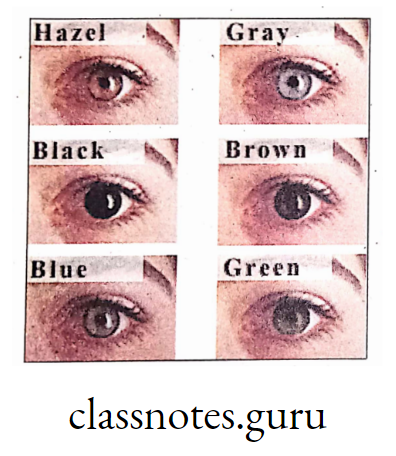
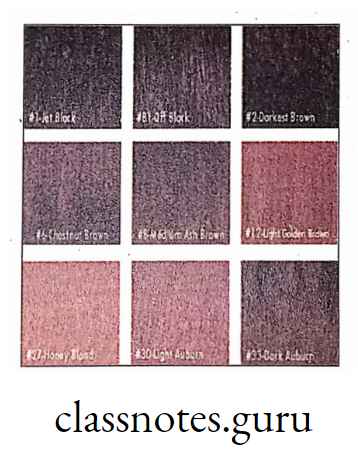
Offsprings do not look exactly like their parents. So, the offspring resemble their parents in major respect but also differ from the parents in. many minor respects.
An Austrian monk, Gregor Johan Mendel performed’ a series of simple experiments and discovered how heredity worked.
Definition: Heredity is the transmission of characteristics or traits through genes from one generation to another by reproduction.
Heredity and Genetic Diseases: Class 10 Science Notes
Read and Learn More Class 10 Science
The term ‘genetics’ was coined by Bateson (1905). It is derived from the Greek word ‘gen’, means “to grow into”, whereas the term ‘gene’ was first proposed by Johannsen (1909).
The science of heredity and the principles governing the inheritance of characters from parent to the progeny (i.e. next generation offsprings) is called genetics.
Mutation—Sometimes there may be some change in chromosome structure or chromosome number or alteration in composition of DNA of a gene. This change in genetic constitution of an organism is called mutation.

Mutation is the cause of variation among organisms. Mutation gives rise to origin of new characteristics or adaptive changes that may result into evolution in the long run. That s why it is sai,”Mutation is the raw material of evolution”.
Any mutation or variation may have some good effects or bad effects.
Variation—The permanent change in chromosome or DNA may result in expression of characters, called as variation. So. variation signifies any difference between cells or individual organisms or groups of organisms of any species.
This is caused either by genetic difference (genotypic variation) or by the effect of environmental factors on the external manifestation of the organisms (phenotypic variation).
Variation shows deviation in characters in an individual from the group to which it belongs or deviation in characters of offspring from those of its parents. Genotypic variation may result Into phenotypic variation.
So, mutation is the cause variation whereas variation is the effect of mutation.
Examples of variation in man :
Free and attached ear lobe —In man, if ear lobes hang free, it is called free or detached ear lobe. On the contrary, if the ear lobes are connected directly to the sides of head, they are attached.

This variation in different persons Is controlled by genes. Free ear lobe is dominant trait and that of attached ear lobe is recessive trait.
Roller and normal tongue—Some people can curl up (fold) the sides of their tongue to form a tube shape called tongue rolling, while others can not. It has been proposed tongue rolling Is due to genetic variation (but sometimes it might be a learning process also (environmental factor)].

Roller tongue Is dominant variation whereas normal unfolded tongue is recessive variation.
Key terms associated with heredity:
Characteristics: Definition—All special features of an organism that are transmitted through genes from one generation to next are called characteristics, e.g. Eye colour, height
of a person, gender (sex), blood groups, skin colour etc.
Traits: Definition—The phenotypic expression of a particular characteristic is called trait e.g. Eye colour is the characteristic whereas a trait would be blue eyes or brown eyes etc.
Allele or Allelomorph: Definition—The contrasting pair of genes located in the same locus of the homologous chromosome and control same characteristic are called allele
or allelomorph, e.g.
In a hybrid tall plant, T (Tall plant) and t (dwarf plant) genes are alleles. Similarly gene for brown eye colour (B) and blue eye colour (b) are also alleles.
Locus: Definition—The point or place on a chromosome where a particular gene is present is known, as locus of that gene. e.g. a chromosome may contain many loci linearly
present on a chromosome.
Each gene is present at a definite locus on the chromosome.
Unit of inheritance (Factor/Gene): Definition—Gene is a part of DMA, located on a particular point (locus) of a chromosome, functions as hereditary unit (responsible for inheritance of characteristics from parents to offsprings), also controls biological functions.
G. j. Mendel, father of genetics, called these genes as ‘’factors’ which control all the characteristics of an organism, e.g. Gene for tallness and gene for dwarfness in pea plant; gene for black hair colour and white hair colour in guineapig etc.
Monohybrid cross: Definition—The genetic experiment of cross breeding where only one pair of contrasting character (i.e. two alternate traits of a particular character) is considered
is known as monohybrid cross, e.g.
In Mendel’s experiment, the cross between pure tall and pure dwarf pea plant; in guineapig, the cross between pure black hair and pure white hair etc.
Dihybrid cross: Definition—The genetic experiment of cross breeding where two pairs of contrasting characters (i.e. two alternate forms of two different characters) considered is known as dihybrid cross, e.g.
In Mendel’s dihybrid cross with pea plant, he considered shape of seed (Round or Wrinkled) as well as colour of seed (Yellow or Green); in Guineapig, hair colour (Black or White) as well as texture of hair (Rough and Smooth).
Homozygous organisms: Definition—Whan the pair of genes present in the corresponding locus of the homologous chromosome are exactly same, the organism is called as
homozygous organism, e.g. homozygous tall pea plant (IT), homozygous dwarf pea plant (tt) etc.
Heterozygous organism: Definition-When the pair of genes (alleles) present in the corresponding locus of the homologous chromosome are of contrasting type, the organism
is called as heterozygous organism e.g. heterozygous tali pea plant (Tt); heterozygous black guineapig (Bb) etc.
Hybridization: Definition—it is the process of interbreeding between two genetically different (divergent) individuals. They may be of same species (intraspecific hybridization) or
different species (interspecific hybridization), e.g.
In Mendel’s monohybrid cross, there cross breeding or cross pollination between pure tali plant and pure dwarf plant.”
Pure and hybrid: Definition—Homozygous organisms are known as pure organisms and hetero-zygous organisms are called hybrid organisms, e.g, homozygous tall pea plant isTT, which Is also known as pure tall, whereas heterozygous pea plant is Tt, which is known as hybrid tall.
Parental generation: Deflnition-The first -set of parents used in the cross of a genetic experiment is called parental generation. So the generation from where a genetic experiment starts is known as parental generation and is represented by P. e.g.
In Mendel s monohybrid cross, parental generation (P) Consists of the pure tall and pure dwarf plants that were cross-pollinated.
Filial generation (F1, F2): Definition—In a genetic experiment, all the offsprings produced from the parental generation (P) are together known as filial generation. It is
represented by F.
The first generation offspring of the parental generation is known- as First filial generation (F1) and the offspring of F1 is known as second filial generation (F2) and so on. e.g.
In Mendel’s monohybrid cross in F1 generation, all plants were hybrid tall. In F2 generation, there were 3/4 tall plants and 1/4 dwarf plants.
Dominant characteristics: Definition—Out of two contrasting alleles in a hybrid organism, one is expressed and other is suppressed—the expressed phenotype is known as
dominant characteristic, the expressed gene is called dominant gene and the phenomenon is known as dominance, e.g.
In Mendel’s experiment, gene (factor) for tallness of plant (T) is dominant over the gene for dwarfness of plant (t); in Guineapig, black hair colour (B) is dominant over white hair colour (b).
Recessive characteristics: Definition—In a hybrid organism, out of two contrasting alleles, one is expressed and other is suppressed—the suppressed phenotype is known as recessive
characteristic, the suppressed gene is -called as recessive gene and the phenomenon is known as recessiveness. e.g.
In Mendel’s monohybrid cross, gene (factor) for dwarfness (t) is recessive to gene for tallness (T); in Guineapig, white hair coiour (b) is recessive to black hair colour (B).
Heredity and Genetic Inheritance NCERT Class 10 Notes
Phenotype and Genotype: Definition—The externally visible (or measurable) characteristics of an organism are called as phenotype, e.g. Tall plant, dwarf plant, red flower, .white flower, black eye, blue eye etc.
Definition—The genetic constitution of an organism is called genotype. It is represented by some symbols to explain the composition of genes of a particular character, e.g. gene for
tallness is represented by (T), that of dwarfness by (t); the genotype of a pure tall plant is TT, that of hybrid tall plant is (Tt) etc.
In Mendel’s monohybrid cross, phenotype and genotype can be explained as follows :
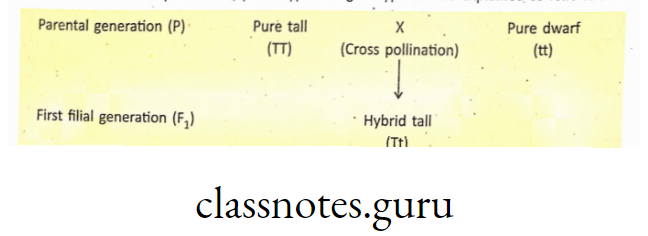
In the above example, phenotype of the P generation plants were pure tall and pure dwarf and their corresponding genotype were (TT) and (tt) respectively. In the first filial generation
(F1) all the offspring plants were hybrid tall.
Here ‘hybrid tall’ is the phenotype and the genotype is (Tt). Usually dominant gene is represented by capital letter and recessive gene by small letter to explain genotype.
Differences between Homozygous (pure) and Heterozygous (hybrid) :

Differences between Dominant and Recessive characters :
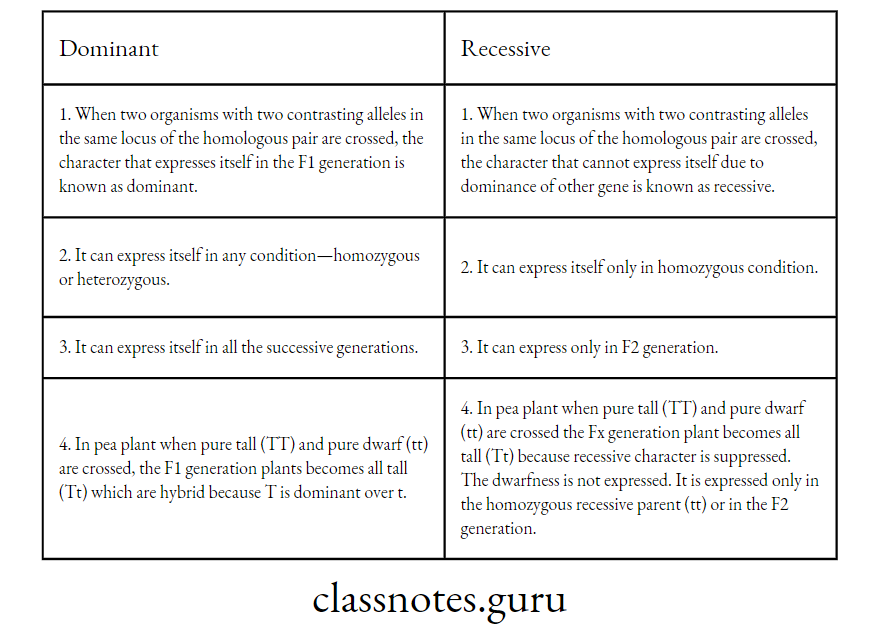
Differences between Phenotype and Genotype :
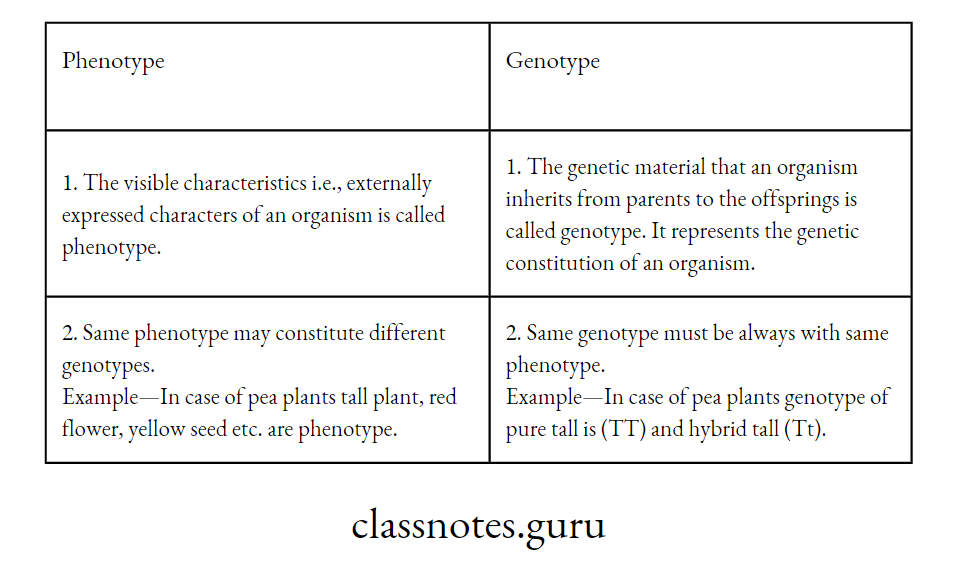
Mendel’s work on Pea plant :
Gregor Johann Mendel (1822—1884) is known as “Father of genetics” because he was the first person to demonstrate the mechanism of inheritance of characters from parents to offsprings.
Mendel studied Botany and Physics in the University of Vienna. He was a priest in St. Thomas Church in Austria.
In 1856, Mendel observed the varieties of characteristics of pea plants in his monastery. He performed varieties of experiments (1856-1866) of self pollination and cross pollination with the pea plants.
Mendel’s research work was not recognised by the contemporary scientists for various reasons. Mendel died in 1884 without any recognition.
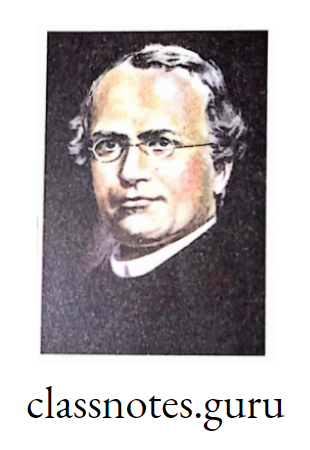
Self and Cross-pollination with pea plants: Mendel selected Garden pea (edible pea) plant (Pisum sativum; 2n = 14) for his experiments. Mendel performed his experiment at a time when there was no concept of chromosome, DNA, gene, meiosis and so on.
For Self-pollination, Mendel covered the bisexual flowers of pea plant by paper bags so that no foreign pollen grain could contaminate the flowers during experiment.
For cross-pollination, Mendel followed three steps :
- Emasculation—From the selected bisexual flowers, the stamens were cut off by a scissor as if the masculine part of the flower was removed.
- Dusting—With the help of brush, the pollen grains of one flower were transferred to the stigma of another flower and vice versa.
- Bagging – After cross pollination oil the flowers were covered with paper bags to avoid any Contamination of undesired pollen grains.
Finally all fir fertilization, the ovary of the flower was modified into fruit (pea pod) and ovules wore modified Into seeds. When the seeds were matured, they were collected and put Into the soil, then the seeds germinated into new saplings (F1 generation).
Genetic Diseases in Humans: Heredity and Inheritance
Reasons behind mendel’s success:
Mendel performed his experiments when biologists were unaware of the chromosome, DNA, genes etc and also the process of cell division (mitosis or meiosis). Even the process of
union between gametes during sexual reproduction was not very clear.
Simply on the basis of his breeding (hybridization) experiments, Mendel came to several conclusions (known as Mendel’s law) which constituted the foundation of modern science of genetics.
The reasons behind Mendel’s success can be explained as. follows :
Mendel repeated his experiments many times to accumulate a good deal of data for statistical analysis.
He analysed the data by applying principles of Mathematics and Statistics confirmed his conclusions or laws.
Mendel conducted his experiment with extreme care and considered one or two pairs of contrasting character for monohybrid and dihybrid cross respectively.
He considered only distinctive contrasting pairs of characters for his hybridization experiment. So, there was no confusion on the results e.g. Tall plant was 6-7′ whereas dwarf plant is 1-1×1/2.
Hence there is no possibility of any overlapping result of tall and dwarf plant.
By repeated Inbreeding (self-pollination) over the generations, Mendel selected only pure breeding varieties of pea plant for his experiment.
Mendel took enough care to avoid contamination of foreign pollen grain by covering the flowers with paper bags.
Mendel did not select those characters that were present on same chromosome—thus he avoided the complexity of linkage, crossing over etc.
Mendel’s chosen contrasting characteristics in pea plant:
Mendel’s experiment and Mendel’s laws: (How did Mendel derive the laws of heredity from his experiments ?)
Mendel performed monohybrid and dihybrid crosses with seven pairs of contrasting characters and from these experiments, he derived laws of inheritance.
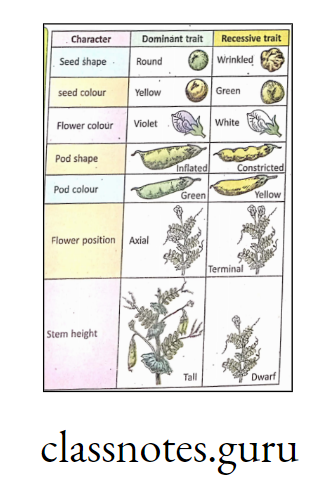
Monohybrid Cross :
Definition: The genetic experiment of cross breeding between two varieties of same species bearing one pair of contrasting traits is known as monohybrid cross.
Experiment and Analysis of results of Monohybrid cross in Pea Plant: Mendel performed several monohybrid experiments taking each of the seven pairs of contrasting
characters separately and obtained similar result.
However, his monohybrid cross on length of pea plant (Tall and Dwarf variety) is very famous.
Experiment :
Mendel first selected pure tall pea plant (6′-7′) and pure dwarf pea plant (1′-1×1/2′) by repeated inbreeding (self pollination) generation after generation. Thus he selected parental generation (P) of pure tall arid pure dwarf plants.
In P generation,Mendel cross pollinated pure tall plants with pure dwarf plants by the process of emasculation, dusting and bagging. In first filial generation (F1) all the plants appeared tall and there was no dwarf plant at all.
All the plants were self pollinated by bagging. In second filial generation (F2); it was observed that out of total number of 1064 pea plants, 787 were tall plants and 277 were dwarf plants.
So, almost 75% (3/4th) of the plants were tall and 25% (1/4th) were dwarf. Therefore, it comes approximately to a ratio of 3 (Tall): 1 (dwarf) which is called as phenotypic ratio.
Phenotypic ratio of F2 generation in a monohybrid cross is also known as monohybrid ratio.

Analysis of results of Mendel’s monohybrid
According to Mendel, tall and dwarf characters in pea plants are transmitted from one generation to the next by the hereditary units known as factors. (Now-a-days, Mendelian
‘factors’ are known as genes).
He postulated that at least two ‘factors’ are responsible for a particular character. (Presently we know that in higher organisms, chromosomes are present in homologous pair— one paternal and one maternal. So, genes are also present in pair.
Hence, at least two genes (one paternal gene and one maternal gene) are responsible for a particular character).
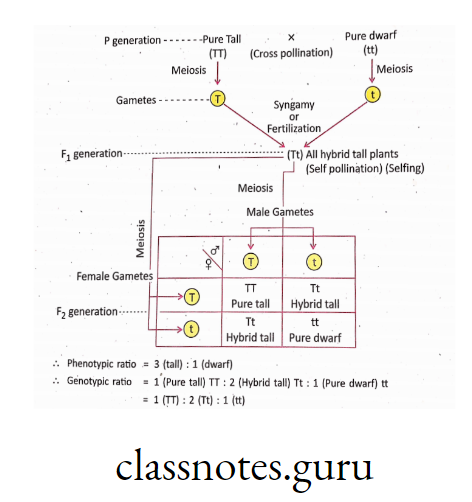
He considered T for tall trait and ‘t’ for dwarf trait. So, in tall plants, the factors will be (TT) and that of dwarf plant (tt).
Mendel also assumed that the ‘factors’ are segregated (separated) during gamete formation (since he had no idea about meiosis). (Now, it. is very dear that the gametes are formed by meiosis which is reduction division where the chromosome number is reduced
to half—so number of genes will be aiso reduced to half]. Thus out of two ‘factors’ (genes),only one factor (gene) would be present in each gamete. He also calculated that during
cross pollination, along with transfer of gametes, there were transfer of ‘factors’ between tall and dwarf plants. So gametes are the bearer of factors.
Hence, from tall plant (TT), the gamete would bear T factor (gene) and that of dwarf plant (tt), the gamete would bear ‘t’ factor.
After cross pollination, T and t unite together to form zygote (Tt). So, the genotype of all F1 plants was (Tt) i.e. hybrid tall plant. In spite of presence of t, only T was expressed, so tall trait (T) is dominant over dwarf (t) and dwarf (t) is recessive to tall (T).
During gametogenesis, the F1 hybrid tall plants produce two types of gametes—(T) and (t) by segregation (meiotic separation). So, two types of male gametes from pollen grains and two types of eggs in ovule were formed.
During self pollination of F1 plants, any male gamete could unite with any female gamete at random that would give rise to F2 generation plants which could be shown by checker board (Punnett Square).
Class 10 Science: Heredity and Mendelian Genetics
Mendel’s conclusion from the results of monohybrid cross :
Concept of two factors—At least two ‘factors’ are responsible for a particular character.
Existence of unit character—’Two- gametes (T) and (t) of two varieties of P generation plants formed the zygote (Tt) from where F1. generation hybrid plants developed. In the hybrid
plants, T and Y ‘factors’ were present side by side and the two ‘factors’ remained perfectly independent from each other without loosing their identities.
So, the factors maintain their purity generation after generation.
Dominance-Out of two contrasting factors—tall (T) and dwarf (t), one unit factor (T) has expressed called dominant and other factor (t) remained hidden called recessive.
Principle of segregation-Dwarf factor (t) was present in P, suppressed in F1 reexpressed in F2. The zygotes of F1 hybrid plant contains two unit character which lie side by side without
mixing.
In F2 generation, the plants produced both parental type (Tall and dwarf) as well as hybrid type. The phenomenon when the hybrid type separates into pure parental and
were hybrid types is called segregation,
Experiment and Analysis of results of Monohybrid cross in Animal (Guineapig):
Many geneticists performed monohybrid cross with animals and obtained resuit like that of Mendel.
Experiment:
When pure (homozygous) black haired guineapigs were crossed artificially with pure (homozygous) white haired guineapigs, all the F1 hybrid guineapigs appeared black haired.
The F2 guineapigs (male and female) were intercrossed.
In F2 generation, the ratio of the offsprings were 3 (Black) : 1 (White).

Analysis of the result :
In P generation, pure black haired guineapig was (BB) and that of white haired (bb).
During gametogenesis, pure black guineapig and pure white guineapig produced (B) and (b) gamete respectively.
In F1 generation, the genotype of hybrid black guineapig, was (Bb). In spite of presence of two contrasting genes of ‘B’ and ‘b’, the F1 animals appeared black which signified black (B) is dominant over white (b).

F1 hybrids produced two types of gametes— (B) and (b)
After intercrossing, the ratio of F2 progeny was 3 (Black) : 1 (White).
Hence, it shows that the inheritance of hair colour in animal like guineapig follows similar method of segregation like that of Mendel.
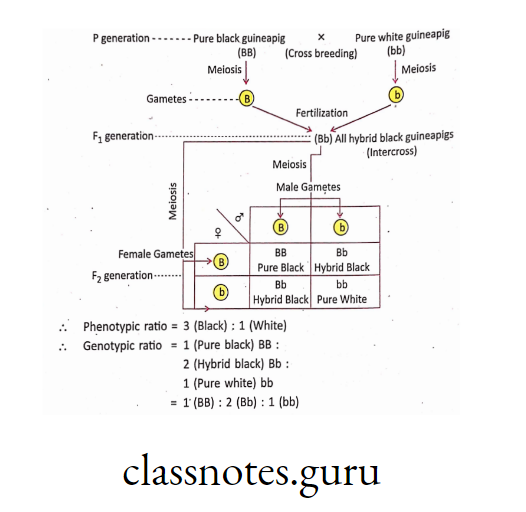
Concept of ‘Dominance’ from Mendel’s experiment :
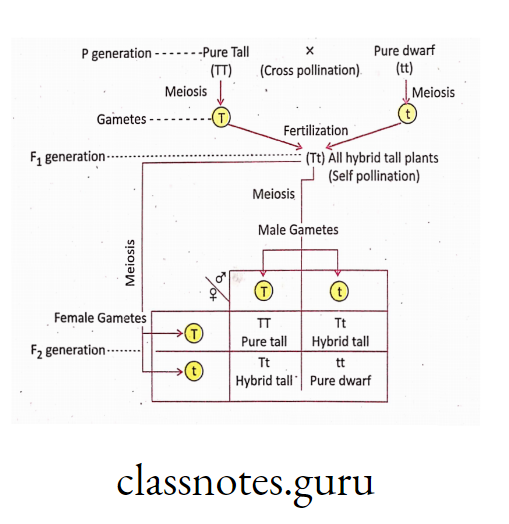
Phenotypic ratio = 3 (Black) : 1 (White)
Genotypic ratio = 1 (Pure tall) TT : 2 (Hybrid tall) Tt : 1 (Pure dwarf) tt
= 1 (TT) : 2 (Tt) : 1 (tt)
Concept of dominance :
In P generation, pure dwarf plant (1 -1×1/2) was present.
In F1 generation, all plants were hybrid tall (Tt) and there was no trace of any draft plant. .
In F2 generation, dwarf reappeared ( 3 tall : 1 dwarf).
The dwarf plants of P generation and F2 generation were exactly same.
In fact the dwarf gene (t) was suppressed in F1 generation by the Tall gene (T). So, T is dominant over ‘t’ gene. Hence T is expressed and ‘t’ is suppressed.
However, in hybrid tall plants (Tt) of F1 generation, t gene was suppressed by ‘V gene but was not destroyed. Moreover, the T and t genes were not mixed up or blended in F1 hybrids but they maintained their individual purity or identity.
That’s why, tt (pure dwarf) plant reappeared in F2 generation. This signifies that dominant gene can suppress the recessive gene but can not destroy the recessive gene.
The genes maintain their purity or potentiality generation after generation (unless it is ‘mutated’). It does not matter whether the gene is expressed or suppressed. A particular genemay be suppressed over the generations but its potentiality remains unchanged.
Dihybrid Cross :
Definition: The genetic experiment of cross breeding between two varieties of same species bearing two pairs of contrasting traits is known as dihybrid cross
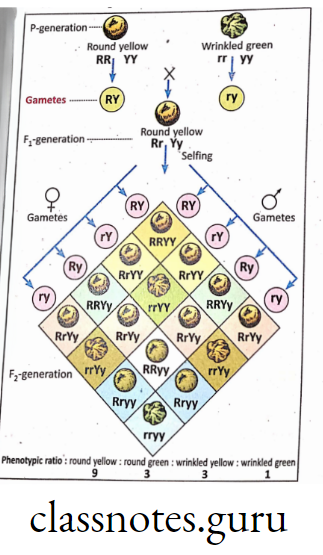
Common Genetic Diseases: Types, Symptoms, and Causes
Experiment and Analysis of results of Dihybrld cross in Pea plant : For dihybrid experiment, Mendel selected two characters-shape of seed and colour of seed (cotyledon).
contrasting traits of shape of seed were round and wrinkled whereas two contrasting traits of colour of seed were yellow and green.
Experiment :
Mendel selected pure round yellow seeded plants and pure wrinkled green seeded Plants by repeated Inbreeding (self pollination) for few generations. Thus he selected parenta
generation (P) of pure round yellow and pure wrinkled green plants.
In P generation, Mendel cross pollinated pure round yellow seeded plants with pure wrinkled green seeded plants by emasculation, dusting and bagging technique.
In F1 generation, all pea plants developed round yellow seeds.
All F1 plants were allowed self pollination.
In F2 generation, it was observed that out of 556 plants produced, 315 were Round yellow, 108 Round green, 101 Wrinkled yellow and 32 were Wrinkled green i.e. 9/16 Round
yellow,3/16 Round green, 3/16 Wrinkled yellow and 1/16 Wrinkled green.
So, the phenotypic ratio was 9:3:3: 1. Phenotypic ratio of F2 progeny in a dihybrid cross is also known as dihybrid ratio.

Analysis Of results of Mendel’s Dihybrid Cross :
In P generation pure round yellow seeded plants were crossed with pure wrinkled green seeded plants. In F1 generation, all offsprings were round yellow which signifies seed is dominant trait over wrinkled seed and yellow colour of cotyledon is dominant green colour of cotyledon.
If we consider, R as round gene (dominant) and r as wrinkled gene (recessive) Y as yellow gene (dominant) and y as green gene (recessive), then in P generation, the genotype
of pure round yellow plant will be RRYY and the genotype of green wrinkled plant, will be rryy.
From pure round yellow (RRYY) plant, the gamete was (RY) and that of pure wrinkled green (rryy) plant, the gamete was (ry).
After fertilization of (RY) and )ry) gametes, the hybrid rouna yellow plants were formed with the genotype RrYy in F1 generation.
The F1 hybrid round yellow plants (RrYy) produced four types of gametes—RY, Ry, rY, ry.
During self pollinadon of F1 plnts,these dour types of male gemetesmunited with form types of female gametes at random. The possible combination of those gemetes to form
zygotes is shown in the checker board or punnett square.

Round yellow = 9, Round green = 3, Wrinkled yellow = 3 and Wrinkled green = 1 Therefore the phenotypic ratio = 9 : 3 : 3 : 1
Mendel’s conclusion from the results of dihybrid
Mendel concluded that the ‘factors’ are separated as well as assorted randomly and independently of each other during gamete formation.
He also concluded that during gametic union (fertilization) any gamete can unite with any other gamete irrespective to its dominance or recessiveness. Since the gametes are
the “bearer of factors” so random union of gametes means random assortment (union) of ‘factors’ or genes.
Thus during gametic union any gene/factor (whether dominant or recessive) can combine independently with any other gene/factor.
Experiment and Analysis of results of Dihybrid cross in Animal (Guineapig).
Experiment :
For dihybrid cross in guineapig, two pairs of contrasting characters were were— hair colour (black or white) and texture of hair (rough or smooth).
In P generation, pure black colour and rough hair variety of guineapig was cross pure white colour and smooth hair variety of guineapig.
In F1 generation, all offsprings appeared with black rough hair.
F1 male and female guineapigs were intercrossed.

In F2 generation, the offspring were in the ratio of 9 (black rough) : 3 (block smooth):3(white rough): 1 (white smooth).

Heredity and Inheritance in Class 10 Science: Key Concepts and Notes
Analysis of results of Dihybrid Cross In Guineapig :
If we consider gene for black hair ‘B’, white hair ‘b’ rough hair ‘R’ and smooth hair r, then in P1 generation, the genotype of pure black rough hair guineapig will be BBRR and that of white smooth hair will be bbrr.
P generation pure Black rough hair guineapig (BBRR) produces’gamete (Bf)) whereas pure white smooth hair guineapig (bbrr) produces gamete (br). These gametes fertilize to give birth to F1 hybrids!
In F1 generation, the hybrid black rough hair guineapig had the genotype BbRr. In spite of presence of white and smooth gene, all offsprings appeared black rough hair which signified black (B) is dominant over white (b) and rough (R) is dominant over smooth (r).
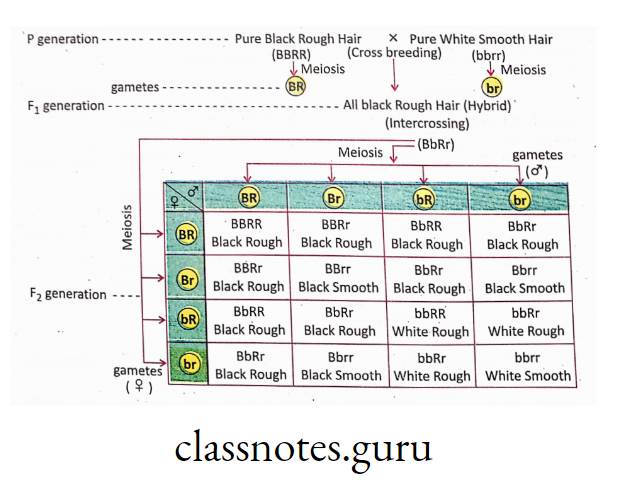
The F1 hybrids (BbRr) produced gametes when Bb and Rr alleles were segregated and assorted independently to produce four types of gametes—BR, Br, bR and br. Thus four types
of male gametes and same four types of female gametes are produced.
These gametes fertilise at random to produce 16 different types of zygotes.
The phenotypic ratio of these zygotes were 9 : 3 : 3 : 1 which can be represented in checker board as follows:
Phenotypic ratio : 9 (Black Rough) : 3 (Black Smooth) : 3 (White Rough) : 1 (White Smooth).
Mendel’s Law :
From monohybrid cross, Mendel formulated his first law known as Law of Segregation.
1st Law of Mendel: Law of Segregation—Factors for contrasting character in a zygote do not blend or contaminate with each other but segregate and pass into different gametes and offsprings randomly.
From dihybrid cross, Mendel formulated his second law known as Law of Independent Assortment.
2nd Law of Mendel: Law of Independent Assortment— Two or more contrasting pairs of factors (characters) are assorted independently and may recombine randomly in all possible combinations governed by chance alone.
Deviation of Mendel’s Laws of Heredity :
In Mendel’s monohybrid cross, tall (T) trait was completely dominant over dwarf (t) trait in pea plant. That’s why, in F1 hybrid tail plants (Tt), T was fully expressed and ‘t’ was totally
suppressed. This is known as complete dominance.
After Mendel, long time passed away. Many scientist made their research work with various plants and animals. Lot of new genetic phenomenon have been discovered. One such
interesting discovery is incomplete dominance.
Definition: In a heterozygous organism, out of contrasting dominant and recessive allele, if the dominant gene cannot express its dominant phenotype completely but an intermediate
or mixed phenotype between dominant and recessive gene is expressed, the phenomenon is known as incomplete dominance or partial dominance or semidominance.
Experiment:
Correns reported incomplete dominance in case of flowers of Four O’ clock plant (Mirabilis jalapa).
In P generation, a pure red flowered plant was cross pollinated with pure white flowered plant.
In F1 generation, all hybrid plants produced pink flowers.
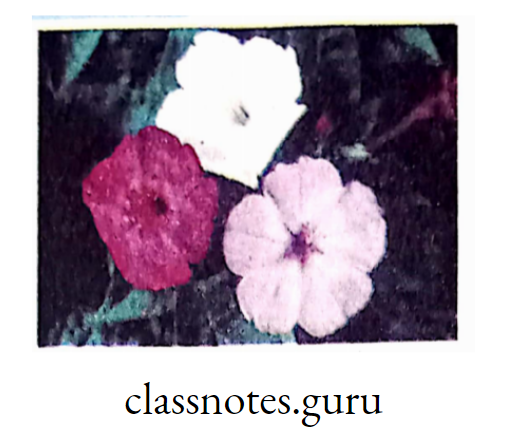
All F1 plants were self pollinated.
In F1 generation, 25% plants produced red flowers, 50% pink flowers and 25% white flowers. Phenotypic ratio = 1 (Red) : 2 (Pink): 1 (White).
Analysis of result :
In P generation, Pure red flowered plant is (RR) and pure white flowered plant was (rr).
During gametogenesis by meiosis, the plant produced (R) and (r) gametes respectively.
After cross pollination of P plants, (R) and (r) unite together to form (Rr) zygote that developed into F1 plants producing pinkflowers.
When the F2 hybrid pink flowered plants were self pollinated, it produced F2 plants in the ratio of 1 (red) : 2 ( pink) : 1 (white).
The genotypic ratio was 1 (RR): 2 (Rr): 1 (rr)

Genetic Disorders: Heredity and Mutation in Class 10 Science
Phenotypic end genotypic ratio are samo In F2 generation,
In F1( hybrids, rod gene (R) did not destroy white gene (r), That’s why, they reappeared In F2 Ronomtion as pure red (RR) and pure white (rr),
In fact, In this example of Mlrabllls Jalapa, red gone Is Incompletely dominant over white gene. So, both red and white genes give rise to an Intermediate pink coloured flowers
in hybrid condition.
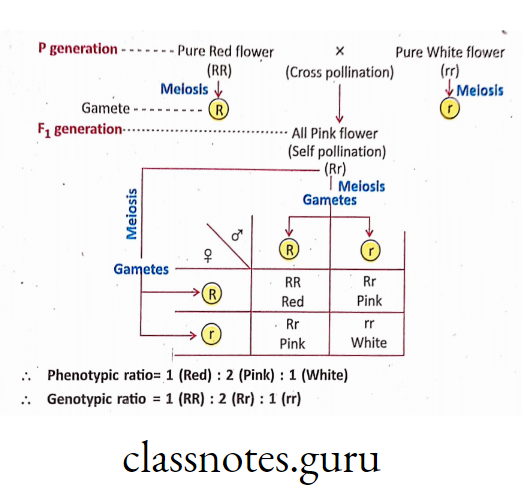
Sex determination in man :
Definition: The mechanism by which the male and female individuals of a species are
differentiated is known as sex determination. In man, mechanism of sex determination is known as XX-XY mechanism.
In human {Homo sapiens), the chromosome number is 2n = 46. There are 22 pairs autosome and 1 pair sex chromosome.
Sex chromosomes determine sex. In human female, the sex chromosomes (allosome) are homologous (XX) but in human male, the sex chromosomes are nonhomologous (XY).
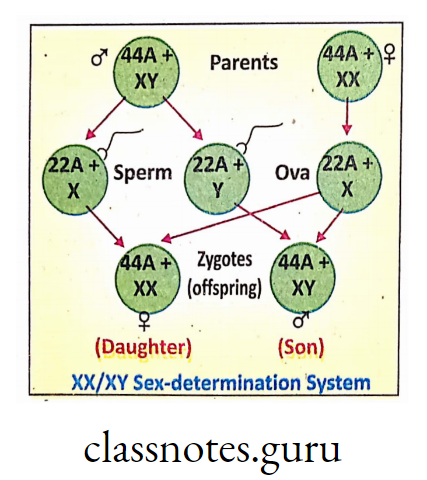
Female (44A + XX) Is homogametic and produces only one type of ovum by meiosis (during oogenesis) (22A + X). (ÿ stands for autosome and ’X for allosome).
Male (44A + XY) is heterogametic and produces two different types of sperm by meiosis (during spermatogenesis) – (22A + X) and (22A + Y). (‘A’ for autosome and X, Y designate
allosome). X containing sperm is known as gynosperm and Y containing sperm is known as androsperm.
During fertilization between sperm and ovum, any type of sperm may fertilize the ovum. Whether gynosperm (22A + X) or androsperm (22A + Y) would fertilize the ovum-is purely
a matter of chance. Nothing can be predicted earlier.
The principle of sex determination in man is that presence of Y in the zygote indicates maleness whereas absence of Y in zygote indicates femaleness.
If gynosperm (22A + X) fertilizes the ovum (22A + X), the zygote would be (44A + XX) which gives birth to a female baby. On the contrary, if androsperm (22A + Y) fertilizes the
ovum (22A + X), the zygote would be (44A + XY) which gives birth to a male baby.
So, whether a male baby (son) or a female baby (daughter) will be born (Sex determination of the baby), depends completely on father and never on the mother (in no way).
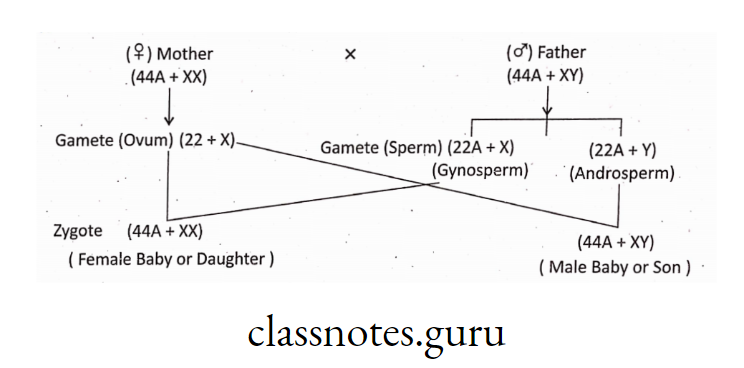

Mendelian Inheritance and Genetic Diseases: Class 10 Science Notes
Some Common Genetic Diseases (What are the causes of genetic diseases?)
Common genetic diseases in population:
Many genetic diseases in man have been discovered. These are mainly because of various mutant genes that are located either in the autosome (autosomal gene) or in the allosome
/sex chromosome (sex linked gene).
If the sex-linked gene is present in the X-chrornosome or Y-chromosome, it may be called as X-linked gene or Y-Iinked gene respectively
Thalassemia : it is a type of haemolytic anaemia caused by abnormal synthesis of faulty haemoglobin. It was discovered by American doctor Cooley (1925).
Cause :
- Thalassemia is a genetic disorder caused by autosomal recessive gene.
- The defects occur due to mutation of genes located in the chromosome 16 and chromosome 11.
- The mutations cause defective synthesis of a globin chain or (3 globin chain of haemoglobin.
- Thalassemia is generally of three types—Alpha, Beta and Delta. (Beta thalassemia is called cooley’s anaemia)
Symptoms :
- Synthesis of less haemoglobin or formation of abnormal haemoglobin.
- Premature destruction of RBC and development of anaemia.
- Expansion of bone narrow and heart problem.
- Enlargement of liver—hepatomegaly.
- Enlargement of spleen—Splenomegaly and increased risk of infection.
- Skeletal deformation and iron overload.
- Retardation of body growth.
- Affected fetus may die inside mother’s uterus or the baby may die soon after birth (jaundice and erythroblastosis).
Haemophilia: It is a clinical condition in which the ability of blood clotting of a person is severely reduced, causing the sufferer to bleed severely even from a slight injury. It is also known as bleeder’s disease. This was first discovered by an American doctor John Otto (1803).
Cause :
Haemophilia is caused due to presence of a recessive sex-linked gene h, located on X-chromosome.
There are two types of haemophilia—Haemophilia A and Haemophilia B, caused by two mutant genes present on the X-chromosome in man with a distinct gap.
Haemophilia A (Royal disease) is caused due to deficiency of a protein for blood clotting known as “Factor 8” or “Antihaemophilic factor” (AHF). About 80% Haemophilia are of this
type.
Haemophilia B (Christmas disease) is caused due to deficiency of another blood clotting protein known as “Factor 9” or Plasma thromboplastin. About 20% Haemophilia are of this
type. It is called Christmas disease according to the name of first patient—Stephen Christmas.
The disease (Haemophilia A) was first discovered in Queen Victoria. Probably the gene was inherited to her from parents or the mutation was developed in herself.
Symptoms :
For normal blood clotting, both factor 8 and 9 are needed. Defect or deficiency of anyone factor will impair blood clotting. So blood does not clot within 3-8 minutes but it takes hours.
As a result, there will be continuous bleeding and the patient may die.
There is no permanent cure of this genetic disease but it may be partly managed by blood transfusion.
Females may be ‘carrier’ with one dominant normal gene and one recessive ‘h’ gene of haemophilia.
Haemophilia is found more in males than in females.
Colour blindness: It is the defective colour vision when someone can not distinguish between certain colours, usually between green and red, and occasionally blue due to absence
or reduced amount of visual pigments.
First scientific paper about colour blindness was wtitten by John Dalton in 1793. Dalton himself was red-green colour blind. That’s why red-green colour blindness is sometimes called as Daltonism.
Cause :
The gene for normal vision is dominant. Red-green colour blindness is caused by recessive gene located on X-chromosome (sex-linked gene) in man.
The mutant gene for red blindness is protan and the mutant gene for green blindness is deutan. They are located at different locus of X-chromosome
Symptoms :
- Colour blindness is inheritable disease of X-linked recessive gene.
- The cone cells of eye in these persons fail to distinguish red and.green colour
- Besides the problem of colour vision, these colourblind persons will have otherwise normal vision for reading, writing etc,
- Colour blindness Is more common In males than In females because males have one X and other Y sex chromosome whereas In human female there are two X-chromosomes.
Thalassemia as an autosomal chromosomal disorder and genetic counselling:
Thalassemia is a type of genetic disorder where haemoglobin Is produced In decreased amounts. The decreased amount of haemoglobin In the blood causes anaemia, which reduces
oxygen carrying capacity of blood. RBC becomes fragile and breaks down easily (haemolysis).
To compensate loss of RBC, frequent blood transfusion is done.
All the above conditions may result into Iron overload, which means excess Iron in the body. Excess iron in vital organs Increases the risk for liver disease (cirrhosis, cancer), heart
attack, diabetes mellltus, osteoarthritis, osteoporosis as Well as problem of endocrine system like hypothyroidism, defective gonads etc.
Iron overload may be inherited or it may be acquired by numerous blood transfusion, iron injection etc. When a person is receiving blood transfusion on a regular basis, iron may build
up to toxic level in the body.
NCERT Class 10 Science Notes: Heredity and Genetic Diseases Overview
Role of genetic counselling In prevention of thalassemia :
Those persons who contain gene for thalassemia in recessive condition are called carriers or minors. They have normal dominant gene. So, they will not suffer from any problem
of thalassemia.
If both father and mother are carrier, then in F1 generation, probability of thalassemia may be 25%.
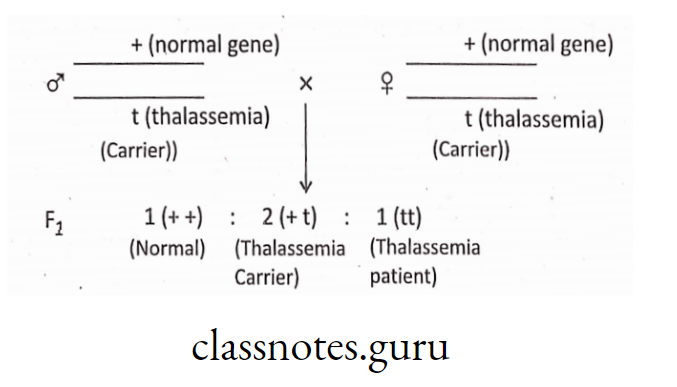
Before marriage of any two man and woman, family history must be studied for genetic counselling to find out any thalassemia carrier in the proposed male and female or their
relatives, parents etc. Two thalassemia carrier should not get married.
There are method of blood test for detection “haemoglobin disorders” which can be done before marriage to find thalassemia carrier (thalassemia minor). These premarital precautions
will help to prevent the Inheritance of thalassemia major (homozygous).
Thus birth of thalassemia babies can be checked that would justify—’prevention Is better than cure’.
